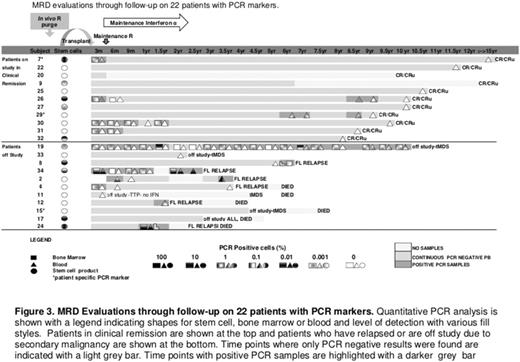Abstract
Introduction
Follicular lymphoma (FL) is an indolent lymphoma with a relapsing remitting course. First line Chemo-immunotherapy followed by maintenance rituximab (R) has demonstrated improvement in progression-free survival (PFS) and overall survival (OS). High dose therapy (HDT) with autologous stem cell transplant (ASCT) at second or third relapse has also been shown to improve both PFS and OS with prolonged remissions reported but its role in the era of chemo-immunotherapy is not yet defined. However, patients with recurrent, high-risk indolent lymphoma may have a short survival and need more effective therapeutic strategies. Strategies incorporating immunotherapies to reduce stem cell contamination or delay recurrence of minimal residual disease (MRD) have been explored. Detailed long-term data, including impact of MRD status on PFS, is lacking for combination approaches such as this. We present long-term (10 year) PFS and MRD on a cohort of 30 patients who received ASCT, proceeded by an R-purge, and followed by maintenance R-Interferon α (IFN α).
Methods
Patients in 1st or 2nd relapse were enrolled in this prospective phase II study. Salvage included CHOP or DHAP with 3 weekly infusions of R prior to stem cell harvest as an "in vivo purge". Patients then received high dose therapy with cyclophosphamide, carmustine and etoposide followed by ASCT. IFN α began at 3m post ASCT for 2y with 6 weekly infusions of R from week 14. Response assessment included clinical, radiographic, and MRD assessments of bone marrow (BM) and peripheral blood (PB). Real-time quantitative PCR was used to evaluate MRD on the apheresis product and on BM and PB Q3m post ASCT for 1y and Q6m thereafter. The primary endpoint of this study was to assess PFS and OS of R-purging and consolidative R-IFN-α in combination with HDT followed by ASCT. Secondary endpoints included the evaluation of stem cell contamination and MRD and the identification of factors that influence clinical outcome and long-term toxicities. An extension study was conducted on patients remaining in clinical remission to assess long term MRD status and immune related effects of this treatment approach.
Results
From July 2000 to September 2009, 36 patients were enrolled with a median age of 47y (30-66y). Sixty-seven percent of patients had stage IV disease, 50% had a FLIPI score of 3 or 4 and the median time from previous chemotherapy to enrolment was 12.8m. Six patients were not transplanted.
With a median follow-up of 10.3 years, incorporating immunotherapy increased the CR rate post HDT/ASCT. The median PFS was 7.8 years in the intent to treat population (n=36) and not reached for the transplanted group (n=30). The median OS was not reached for either group but significantly improved in the transplanted group, the 10yr OS was 68.9% for the intent to treat and 76% for the transplanted group. The presence of MRD positive stem cell product did not adversely affect patient outcomes. Of the 30 transplanted, there were PCR markers for 22 (73%). Although 10/22 (45%) stem cell collections were MRD+, PFS was not significantly different from patients transplanted with MRD- grafts. A plateau in OS was seen at 8 years, with patients in long-term CRs maintaining MRD negativity. By univariate and multivariate analysis, remission duration pre-enrolment and presence of molecular relapse at any time-point post ASCT are important predictors for outcome in this cohort. The main toxicities associated with this strategy include an increased second malignancy rate (10% at 5yrs, 20% 7.5yrs, 26% at 10yrs) in the transplanted cohort and prolonged asymptomatic hypogammaglobulinemia (33% in extension phase).
Conclusion
The data from this trial and from our previous sequential trials (Berinstein , et al 2015) suggest that the outcomes from transplantation for recurrent high-risk FL are enhanced by utilizing R maintenance and/or as an in vivo purge and that the addition of IFN-α maintenance adds minimal long-term benefit. Prolonged PFS and OS are achievable with this approach even in high risk patient populations. The 50% rate of molecular remissions in measurable patients and the plateau in PFS and OS combined with the long follow-up are suggestive of compete eradication of the lymphoma in some patients. In vivo purge and maintenance strategies with rituximab added to HDT are safe, feasible and promising.
Buckstein: Celgene: Honoraria, Research Funding; Astex: Honoraria.
Author notes
Asterisk with author names denotes non-ASH members.


This feature is available to Subscribers Only
Sign In or Create an Account Close Modal